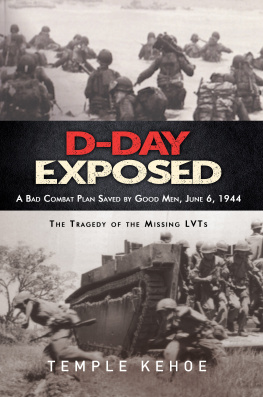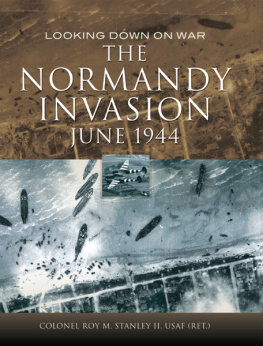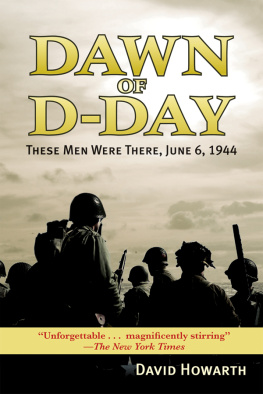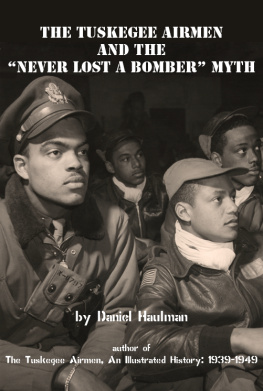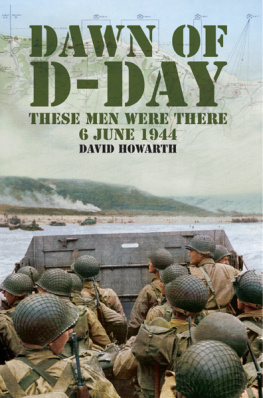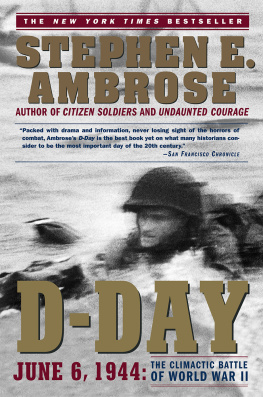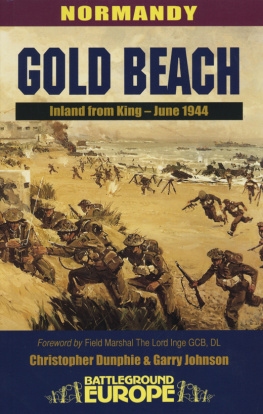Temple Kehoe - D-Day Exposed: A Bad Combat Plan Saved by Good Men, June 6, 1944
Here you can read online Temple Kehoe - D-Day Exposed: A Bad Combat Plan Saved by Good Men, June 6, 1944 full text of the book (entire story) in english for free. Download pdf and epub, get meaning, cover and reviews about this ebook. year: 2018, genre: History. Description of the work, (preface) as well as reviews are available. Best literature library LitArk.com created for fans of good reading and offers a wide selection of genres:
Romance novel
Science fiction
Adventure
Detective
Science
History
Home and family
Prose
Art
Politics
Computer
Non-fiction
Religion
Business
Children
Humor
Choose a favorite category and find really read worthwhile books. Enjoy immersion in the world of imagination, feel the emotions of the characters or learn something new for yourself, make an fascinating discovery.
- Book:D-Day Exposed: A Bad Combat Plan Saved by Good Men, June 6, 1944
- Author:
- Genre:
- Year:2018
- Rating:4 / 5
- Favourites:Add to favourites
- Your mark:
- 80
- 1
- 2
- 3
- 4
- 5
D-Day Exposed: A Bad Combat Plan Saved by Good Men, June 6, 1944: summary, description and annotation
We offer to read an annotation, description, summary or preface (depends on what the author of the book "D-Day Exposed: A Bad Combat Plan Saved by Good Men, June 6, 1944" wrote himself). If you haven't found the necessary information about the book — write in the comments, we will try to find it.
Temple Kehoe: author's other books
Who wrote D-Day Exposed: A Bad Combat Plan Saved by Good Men, June 6, 1944? Find out the surname, the name of the author of the book and a list of all author's works by series.
D-Day Exposed: A Bad Combat Plan Saved by Good Men, June 6, 1944 — read online for free the complete book (whole text) full work
Below is the text of the book, divided by pages. System saving the place of the last page read, allows you to conveniently read the book "D-Day Exposed: A Bad Combat Plan Saved by Good Men, June 6, 1944" online for free, without having to search again every time where you left off. Put a bookmark, and you can go to the page where you finished reading at any time.
Font size:
Interval:
Bookmark:
A Bad Combat Plan Saved by Good Men,
June 6, 1944
The Tragedy of the Missing LVTs
Temple Kehoe
Copyright 2014 Temple Kehoe
Edited by Susan Kehoe
www.dday-exposed.com
ISBN 978-1-925171-32-7 (eBook)
EPUB Edition
Published by Vivid Publishing in 2014
P.O. Box 948, Fremantle Western Australia 6959
www.vividpublishing.com.au
eBook conversion and distribution by Fontaine Publishing Group, Australia
www.fontaine.com.au
All rights reserved. No part of this publication may be reproduced, copied or transmitted in any form or by any means, electronic, mechanical, photocopying, recording or otherwise, without the prior written permission of the copyright owner.
License Notes
This ebook is licensed for your personal enjoyment only. This ebook may not be re-sold or given away to other people. If you would like to share this book with another person, please purchase an additional copy for each recipient. If youre reading this book and did not purchase it, or it was not purchased for your enjoyment only, then please return to your favorite on-line retailer and purchase your own copy. Thank you for respecting the hard work of this author.
I fear no enemy,
I fear our mistakes.
Thucydides, Ancient Greece, 460-395 BC author of The Peloponnesian Wars
The good company, platoon or section (squad) leader, who carries forward his men or holds his post and often falls unknown. It is these men who in the end do most to win wars.
Britains Field Marshal Wavell, World War 2
For want of a nail a shoe was lost
For want of a shoe a horse was lost
For want of a horse a message was lost
For want of a message a battle was lost
For want of a battle a kingdom was lost.
This childrens rhyme states a timeless combat rule think in systems terms.
A nation that makes a great distinction
between its scholars and its warriors will
have its laws made by cowards and its
wars fought by fools.
Thucydides, Ancient Greece, 460-395 BC
World War 2 was at a crossroads. In June 1944 Germany and USA were in a desperate race to develop nuclear weapons. Russia was in the process of defeating Nazi Europe from the west, and if the Allies did not liberate Western Europe first, Russia could roll all the way to the English Channel, absorbing the whole of Europe into Communist Russia. Britain was weakening after five years of war and America and Britain knew they needed to take the war back to the European mainland and to Germany within the next month or they would have missed the opportunity to defeat Germany for another year. Another year would be too long.
Britain under Churchills leadership had been planning an invasion to liberate Europe from Nazi occupation since 1940 and Dunkirk. Now might be the last chance.
On the evening of June 5 1944, the largest armada in world history was massing to launch an invasion of Europe through Normandy the following morning. Four years of planning with some of the best brains in the combined Allied forces had gone into the attack.
Thousands of craft carrying 154,000 troops from Britain, United States and Canada were to land on five beaches code named Utah, Omaha, Gold, Juno and Sword. These beaches ran west to east along the Normandy coast of France on the English Channel. Elaborate decoy bombing and diversionary activities had occurred to disguise the Allied plans and distract the Germans from the intended landing points.
The troops had been told intensive aerial bombing would destroy German defences along the beaches, and naval bombardment would destroy most of what was left before they landed. Mine clearing tanks and main battle tanks would be landed before troops arrived and would clear the way for them and provide protective fire to deal with any remaining German defences.
The first wave landings showing D-Day invasion targets (dotted lines) compared to actual areas captured by the end of D-Day (black areas).
They were told that only first wave troops would need to fight on the beaches and those would merely have the job of clearing up the little remaining German resistance after the bombers, the warships and the tanks had destroyed most of the defenses. They were told the quality of the German troops was poor and so they would strike little resistance from any remaining German soldiers, enabling them to quickly establish a secure entry point for the main invasion forces. They were told the task of the second and all following waves was to move over captured beaches and advance quickly inland to capture the D-Day objectives along the Caen to Sainte-Mere-Eglise highway by nightfall, and then dig in to be ready to repel the certain German counter-attacks.
What really happened was very different and is best described by first-hand accounts from both allied and German troops who survived:
Sergeant J. Robert Slaughter, aged 19, D Company, 1 st Battalion, U.S. 116 th Infantry Regiment, 29 th Division who landed in the first wave on Omaha:
I watched the movie The Longest Day and they came charging off those boats and across the beach like banshees, but that isnt the way it happened. You came off the craft, you hit the water, and if you didnt get down in it you were going to get shot. There were dead men floating in the water and there were live men acting dead, letting the tide bring them in.
D-Day June 6,1944: The Climactic Battle of World War II , Stephen E. Ambrose, 1994, p. 343-344.
Men of E Company were put out in waist-deep water, but hit a deep runnel [channel] as they waded in, and had to swim through surf and strong currents, which wrenched them east. Flamethrowers, mortars, bazookas, and small arms were all dropped in the struggle for survival.
Invasion 44: The Full Story of D-Day , John Frayn Turner, 1959, p. 140.
First wave troops delivered by Higgins boats to Omaha Beach heavily loaded and exposed to machine gun fire while wading ashore on Omaha Beach.
British Royal Marines Sub-Lieutenant Jimmy Green was the commander of a flotilla of British landing craft that carried some of the 1st Wave of American troops to the bloodiest beach Omaha:
We were told that the beach would have craters in it so that the troops would be able to shelter. It was going to be a wide sandy beach with obstacles but the American air force the night before was supposed to bomb the beach and cause craters and the [warship and rocket ship] bombardment was also supposed to do something of that sort. But, when I gave the order to go into line abreast there were no marks at all. There was a virgin beach stretching for three hundred yards with not a sign of any place where the troops could shelter: they had to cover an open beach with the Germans waiting for them in the darkness of the cliffs. Although at half-past-six it was lightish, it was still a grim, depressing sort of morning and the cliffs looked very foreboding and sinister and we knew that Germans were there because they were popping mortars at us.
I spoke to the captain of A Company of the 116th and said, Theres the beach, where do you want to land? He said, I want to land to the right of the pass, just there, and I want the other group to land to the left of the pass so that when we go up the beach we can converge on the entrance to the pass. So I gave the order to go full speed ahead, we saw the beach ahead of us, we made for the spot, and we crunched to a halt, because the beach was very shallow about twenty five yards from the shoreline. I didnt expect to hit it just there, so there was a bit of a shudder, we all staggered a bit. We lowered the ramp and the Americans started to file out in single file. They had to go out in single file because it was a narrow door and they plunged into the surf and they were going up and down and they had to keep their weapons dry so they had to hold them over their heads. One minute the surf was round their ankles, the next minute it was under their armpits and we had to keep the boat steady as they were getting out to assist them in their disembarkation.
Font size:
Interval:
Bookmark:
Similar books «D-Day Exposed: A Bad Combat Plan Saved by Good Men, June 6, 1944»
Look at similar books to D-Day Exposed: A Bad Combat Plan Saved by Good Men, June 6, 1944. We have selected literature similar in name and meaning in the hope of providing readers with more options to find new, interesting, not yet read works.
Discussion, reviews of the book D-Day Exposed: A Bad Combat Plan Saved by Good Men, June 6, 1944 and just readers' own opinions. Leave your comments, write what you think about the work, its meaning or the main characters. Specify what exactly you liked and what you didn't like, and why you think so.

